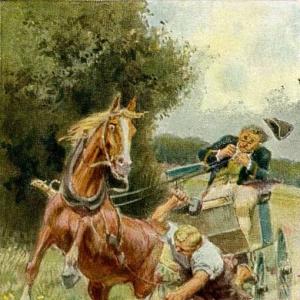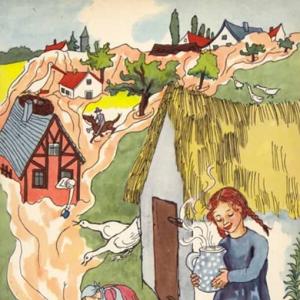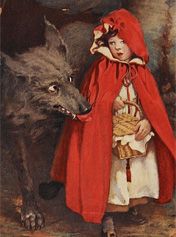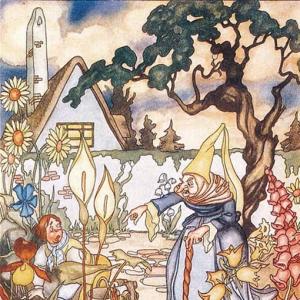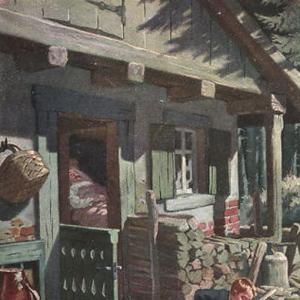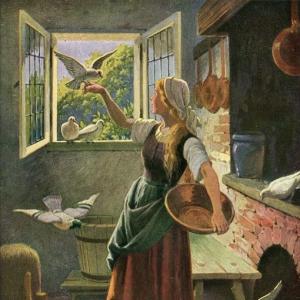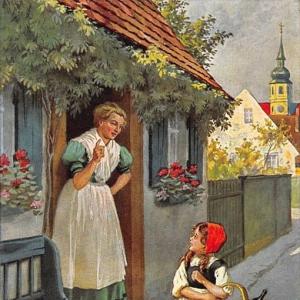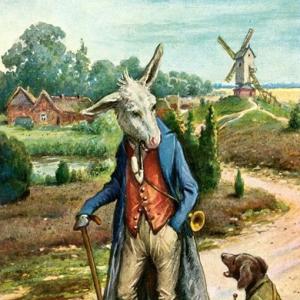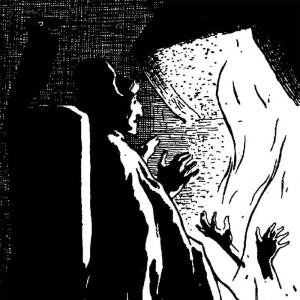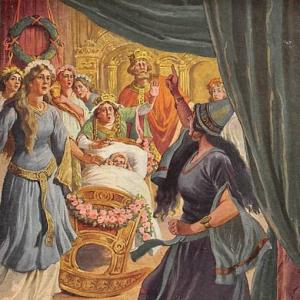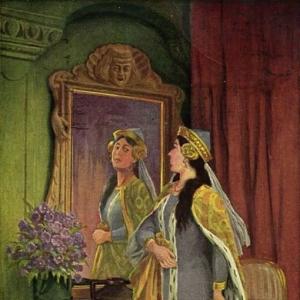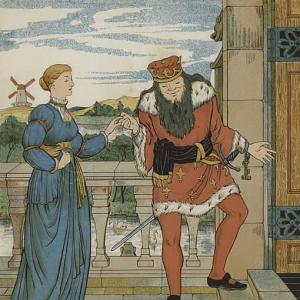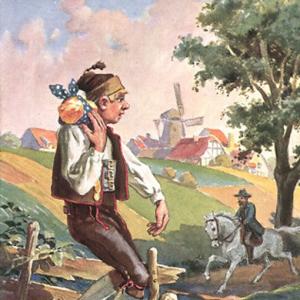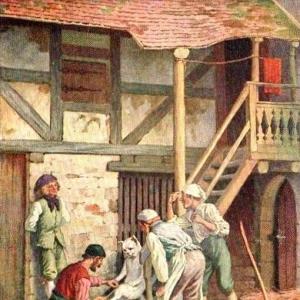Reading time: 4 min
There was once on a time a shepherd boy whose fame spread far and wide because of the wise answers which he gave to every question. The King of the country heard of it likewise, but did not believe it, and sent for the boy. Then he said to him: „If thou canst give me an answer to three questions which I will ask thee, I will look on thee as my own child, and thou shall dwell with me in my royal palace.“ The boy said: „What are the three questions?“ The King said: „The first is, how many drops of water are there in the ocean?“
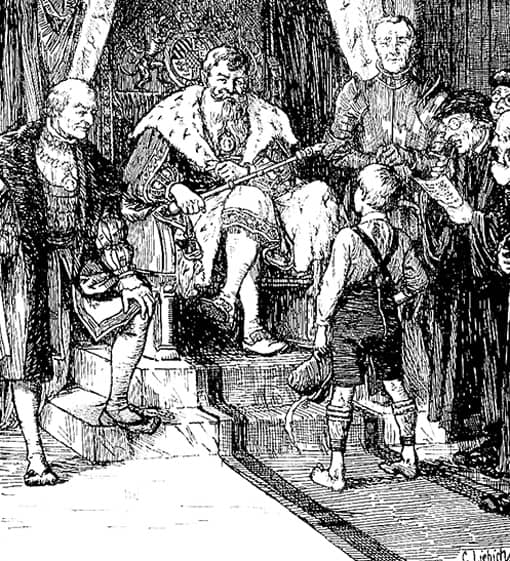
The shepherd boy answered: „Lord King, if you will have all the rivers on earth dammed up so that not a single drop runs from them into the sea until I have counted it, I will tell you how many drops there are in the sea.“ The King said: „The next question is, how many stars are there in the sky?“ The shepherd boy said: „Give me a great sheet of white paper,“ and then he made so many fine points on it with a pen that they could scarcely be seen, and it was all but impossible to count them; any one who looked at them would have lost his sight. Then he said: „There are as many stars in the sky as there are points on the paper; just count them.“ But no one was able to do it. The King said: „The third question is, how many seconds of time are there in eternity.“ Then said the shepherd boy: „In Lower Pomerania is the Diamond Mountain, which is two miles and a half high, two miles and a half wide, and two miles and a half in depth; every hundred years a little bird comes and sharpens its beak on it, and when the whole mountain is worn away by this, then the first second of eternity will be over.“
The King said: „Thou hast answered the three questions like a wise man, and shalt henceforth dwell with me in my royal palace, and I will regard thee as my own child.“
 Learn languages. Double-tap on a word.Learn languages in context with Childstories.org and Deepl.com.
Learn languages. Double-tap on a word.Learn languages in context with Childstories.org and Deepl.com.Backgrounds
Interpretations
Adaptions
Summary
Linguistics
„The Shepherd Boy“ is a fairy tale collected by the Brothers Grimm, who were German scholars and linguists named Jacob and Wilhelm Grimm. The Brothers Grimm were well-known for their work on folklore, and they collected and published hundreds of European fairy tales, many of which are still popular today. Their collection, titled „Kinder- und Hausmärchen“ (Children’s and Household Tales), was first published in 1812 and went through multiple editions during their lifetimes.
The Brothers Grimm collected these tales from various sources, including oral traditions, written manuscripts, and the works of other collectors. They aimed to preserve the cultural heritage of their country and to provide moral and educational lessons for children through these stories. Their collection includes many well-known fairy tales such as „Cinderella,“ „Snow White,“ „Rapunzel,“ and „Hansel and Gretel,“ among others.
„The Shepherd Boy,“ also known as „The Wise Little Boy“ or „The Wise Youngster,“ is a lesser-known tale from the Brothers Grimm’s collection. The story is a prime example of the wisdom and cleverness of the main character, a common theme in many folktales and fairy tales. The tale showcases the ability of the young and humble protagonist to overcome challenges through wisdom and creativity, while also exploring themes such as the limitations of human knowledge and the importance of humility.
While the Brothers Grimm were German, many of the tales they collected have their roots in the oral traditions and folklore of various European cultures. These stories often share common themes, motifs, and narrative structures, making it difficult to pinpoint the exact origin of any given tale. „The Shepherd Boy“ is no exception, as it shares similarities with other stories of wise and clever protagonists who use their wit to overcome seemingly impossible challenges.
„The Shepherd Boy“ is a thought-provoking fairy tale that offers multiple interpretations, with themes such as wisdom, humility, and the power of creative thinking. Here are some interpretations of the story.
Wisdom beyond age and social status: The shepherd boy, despite his humble background, is able to answer the King’s seemingly impossible questions using his wisdom and creativity. This highlights the idea that wisdom is not limited to the upper classes or determined by one’s social status, and that even a young boy from a humble background can possess great insights.
Creative problem-solving: The shepherd boy’s answers to the King’s questions showcase his ability to think outside the box and approach problems from a unique perspective. This emphasizes the importance of creative problem-solving and innovative thinking in overcoming challenges.
The limitations of human knowledge: The King’s questions are designed to be unanswerable, touching on topics such as the vastness of the ocean, the number of stars in the sky, and the concept of eternity. The shepherd boy’s responses highlight the limitations of human knowledge and understanding, suggesting that there are some questions that we may never be able to answer definitively.
Humility: The King’s skepticism of the shepherd boy’s wisdom demonstrates a certain arrogance or pride. By the end of the story, however, the King recognizes the boy’s wisdom and treats him as his own child. This shift illustrates the importance of humility and the willingness to learn from others, regardless of their background or social status.
The power of metaphor: The shepherd boy’s response to the question about eternity uses the metaphor of a bird slowly wearing away a mountain over an unimaginable span of time. This highlights the power of metaphor and storytelling in conveying complex ideas and deep truths.
„The Shepherd Boy“ is a popular fairy tale that has been adapted in various forms, including books, films, and plays. Here are some notable adaptations:
„The Emperor’s New Clothes“ by Hans Christian Andersen: This well-known tale is often compared to „The Shepherd Boy“ because of its similar plot. In Andersen’s version, a vain emperor is tricked into wearing invisible clothes by two swindlers, but a child is the only one brave enough to point out that the emperor is actually naked.
„The Invisible Thread“ by Yoshiko Uchida: This children’s book is a retelling of „The Shepherd Boy“ set in feudal Japan. The story follows a young boy who is gifted with a magical invisibility cloak and uses it to help his community.
„The King’s New Clothes“ by Rumpus Theater Company: This British play is a comedic adaptation of „The Shepherd Boy“ that features music, dancing, and audience participation. The story follows a vain king who hires a new tailor to design his clothes, but the tailor ends up exposing the king’s foolishness.
„The Shepherd Boy Who Became King“ by Enid Blyton: This children’s book is a modern retelling of „The Shepherd Boy“ that emphasizes the importance of humility and kindness. The story follows a young shepherd boy who is crowned king after exposing the previous ruler’s corruption.
„The Shepherd Boy“ (2015) directed by Asif Hasan: This Indian short film is a modern interpretation of „The Shepherd Boy“ that deals with issues of corruption and social justice. The story follows a young man who exposes the corrupt practices of a local politician and inspires the community to take action.
„The Shepherd Boy“ is a fairy tale by the Brothers Grimm that tells the story of a young shepherd boy who was well-known for his wise answers to every question. The King, skeptical of the boy’s wisdom, decided to test him by asking three seemingly impossible questions. If the boy could answer them, the King would treat him as his own child and welcome him to live in the royal palace.
The first question posed by the King was, „how many drops of water are there in the ocean?“ The shepherd boy cleverly responded that he could answer the question if the King would first dam up all the rivers on Earth, preventing any water from flowing into the sea until the boy had counted each drop.
The second question was, „how many stars are there in the sky?“ The boy requested a large sheet of white paper and made an enormous number of tiny, almost invisible dots on it. He then told the King that the number of stars in the sky was equal to the number of dots on the paper, which was impossible for anyone to count.
The final question asked by the King was, „how many seconds of time are there in eternity?“ The shepherd boy described a mountain in Lower Pomerania called the Diamond Mountain, measuring two and a half miles in height, width, and depth. He explained that every hundred years, a small bird would come and sharpen its beak on the mountain. Only when the entire mountain was worn away by this activity would the first second of eternity have passed.
Impressed with the boy’s wise answers, the King invited him to live in the royal palace and treated him as his own child, acknowledging the wisdom and insight the shepherd boy possessed.
The fairy tale „The Shepherd Boy“ by the Brothers Grimm presents an intriguing narrative that reflects on wisdom, intelligence, and the relativity of knowledge. Through a linguistic and thematic analysis, the story unravels itself as a rich tapestry of proverbial insights and intellectual gymnastics.
Structure and Style
Dialogue and Syntax: The story is driven largely by dialogue, with the exchanges between the king and the shepherd boy holding central significance. The language is formal and structured, consistent with classical fairy tale syntax. Use of archaic pronouns like „thou“ and „thee“ emphasizes the timeless or historical context in which such tales are often situated.
Rhetorical Techniques: The shepherd boy employs rhetorical strategies such as reductio ad absurdum and illustration by analogy, fitting common aspects of oral storytelling traditions where indirect answers often carry deeper truths.
Thematic Elements
Knowledge vs. Wisdom
Quantifying the Immeasurable: Each question posed by the king embodies an attempt to quantify the immeasurable: the drops in the ocean, the stars in the sky, and time in eternity. The shepherd boy’s responses indicate a profound understanding of the limits of human knowledge and the vastness of the universe.
Wisdom and Wit: The shepherd boy’s witty and wise answers serve as metaphors for the idea that true wisdom involves understanding the limitations of one’s knowledge.
Power Dynamics: The king’s authority is challenged by the shepherd boy’s intellectual prowess, subverting the power dynamics typical of a royal subject interaction. Despite the king’s physical power, the boy’s intellectual superiority grants him a place within the royal palace, portraying intellect as a form of power.
Eternity and Time: By illustrating eternity through the imagery of the Diamond Mountain, the story delves into abstract concepts, inviting readers to reflect on the nature of time and the human condition.
Symbolism
The Shepherd Boy: Symbolic of youthful wisdom and humility, the shepherd boy embodies the archetype of the „wise fool“ who, despite his humble beginnings, possesses profound insights.
The Diamond Mountain: Represents the enduring and unyielding nature of eternity, a concept so vast and incomprehensible that it challenges human understanding.
Cultural and Historical Context
Folklore Tradition: The tale fits within the tradition of European folklore, where shepherds often play the role of unsuspecting wisdom figures. Such tales reflect societal values that esteem wit and intelligence over mere status.
Moral and Education: Common in Grimm’s tales, the story carries didactic elements, teaching that humility and wisdom can elevate one’s status and achieve what might otherwise be impossible.
In conclusion, „The Shepherd Boy“ is a richly layered tale that explores the depths of wisdom and understanding through clever linguistic play and symbolic narrative. Its enduring appeal lies in its ability to provoke thought about the grand mysteries of life and the universe, wrapped in the simplicity and charm of a classic fairy tale.
Information for scientific analysis
Fairy tale statistics | Value |
|---|---|
| Number | KHM 152 |
| Aarne-Thompson-Uther-Index | ATU Typ 922 |
| Translations | DE, EN, DA, ES, FR, PT, FI, HU, IT, JA, NL, PL, RU, TR, VI, ZH |
| Readability Index by Björnsson | 36.2 |
| Flesch-Reading-Ease Index | 76.2 |
| Flesch–Kincaid Grade-Level | 9.6 |
| Gunning Fog Index | 12.3 |
| Coleman–Liau Index | 6.6 |
| SMOG Index | 8.8 |
| Automated Readability Index | 10.5 |
| Character Count | 1.815 |
| Letter Count | 1.381 |
| Sentence Count | 13 |
| Word Count | 363 |
| Average Words per Sentence | 27,92 |
| Words with more than 6 letters | 30 |
| Percentage of long words | 8.3% |
| Number of Syllables | 439 |
| Average Syllables per Word | 1,21 |
| Words with three Syllables | 12 |
| Percentage Words with three Syllables | 3.3% |

 Facebook
Facebook  Whatsapp
Whatsapp  Messenger
Messenger  Telegram
Telegram Reddit
Reddit
